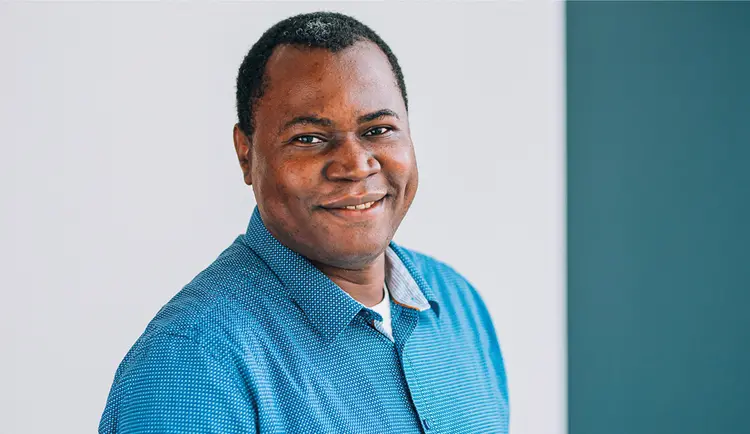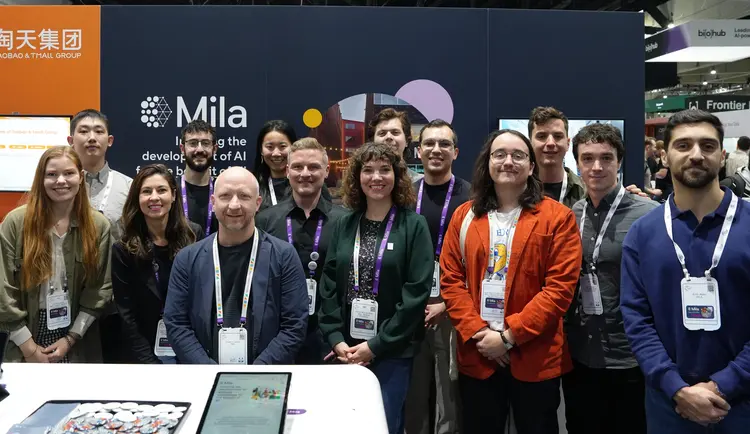
Mila News︱Raymond Chua
Editorial Note: I would like to thank fellow Neural-AI Reading Group organizers, Mandana and Max, as well as Mila’s Scientific Communicator, Brigitte Tousignant, for their assistance in the editing of the content for this blog post.
At the intersection of neuroscience and artificial intelligence, the human brain has long been a rich source of inspiration for building AI with human-like cognitive intelligence. Understanding the brain’s underlying mechanisms can inform the development of novel algorithms and systems that could potentially help researchers better understand cognitive function (Chance et al., 2020). Yet in the last few years, the attention has turned toward the symbiotic growth of AI and neuroscience, and how both fields can actually drive each other forward.
This has led a growing number of researchers, at Mila and elsewhere, to specialize in ‘NeuroAI’, the common term used to define research at the intersection of both disciplines. In 2019, I saw this as an opportunity to create the Neural-AI Reading Group, which continues to run weekly with the help of fellow Mila students Mandana Samiei (PhD, McGill) and Maximilian Puelma Touzel (Post-doc, UdeM).
This post offers insight into the Neural-AI reading group, the Mila researchers currently working at the intersection of neuroscience and AI, and the benefits of engaging with the Mila community through one of its several reading groups.
Neural-AI Reading Group
One of the main goals of the Neural-AI reading group is to allow members of the Mila community with similar interests to come together and critically and constructively discuss scientific papers related to neuroAI. Besides getting to know the wider neuroAI community at Mila, members frequently get to meet key leaders in both fields and have the opportunity to engage in discussions that might bring a new perspective to their own work as well as form collaborations with different researchers. The Neural-AI reading group is open to all Mila members (students, faculty, and staff) and aims to meet on a weekly basis unless there are conferences or semester breaks.
The reading group alternates between journal article discussions and guest speakers. Papers are selected by the organizing committee from scientific journals and neuroscience conferences, such as Computational and Systems Neuroscience (Cosyne), Conference on Cognitive Computational Neuroscience (CCN), or AI conferences such as the International Conference for Learning Representations (ICLR) and Neural Information Processing Systems (NeurIPS). In April 2019, the very first group meeting discussed a prominent review paper published in Neuron – Cell Press, “Neuroscience-Inspired Artificial Intelligence” by DeepMind researchers Demis Hassabis (Founder, DeepMind), Dharshan Kumaran, Christopher Summerfield, and Matthew Botvinick. These authors have previously published several seminal papers on areas concerning biological and artificial learning, providing examples of how AI and machine learning have been used to better understand the brain, contributing to biological-inspired AI systems that aim to address some of the shortcomings found in traditional AI systems.
The reading group also benefits from talks given by invited speakers who present their work in this area. This provides a great opportunity for collaboration and the free-flowing of ideas between Mila members and the speakers. Since the start of the pandemic, many leading experts from all over the world have virtually presented their research during one of the reading group’s sessions, topics including homeostatically motivated intelligence and scale-free cognition, rational thoughts in neural codes, an evolutionary perspective on biological and artificial neural networks, and normative accounts of cognitive fatigue and boredom. We also recently had our first Christmas lecture given by neuroscience expert Jacqueline Gottlieb, Principal Investigator at Columbia University’s Mortimer B. Zuckerman Institute for Mind Brain and Behaviour and Director of the Research Cluster on Curiosity, on “Curiosity and information demand: how we can study them and why we should care.”
Neuroscience and AI at Mila
At Mila, many faculty members are currently working at the intersection of neuroscience and AI, namely, Blake Richards, Irina Rish, Guillaume Lajoie, Eilif Muller, Danilo Bzdok, Pouya Bashivan, Julien Cohen-Adad, Guillaume Dumas, and Yoshua Bengio. Below is a sample of some of their current research themes:
- Blake Richards (McGill) is the Principal Investigator at LiNC Lab which focuses on three major research areas: (1) the credit assignment problem in both biological and artificial neural networks; (2) applying knowledge about natural memory to develop memory systems for artificial neural networks with greater flexibility and insight; and (3) the development of machine learning tools to seek a better understanding of underlying neural computation principles.
- Irina Rish’s (UdeM) lab primarily works on continual learning, reinforcement learning, and decision-making models in humans and AI. Currently, members of her lab are involved in improving the stability, consistency, and robustness of models learned from fMRI across different subjects. She is also overseeing a research project on dynamical systems modeling of neuroimaging data, such as calcium imaging. Professor Rish currently holds the Canada Excellence Research Chair (CERC) in Autonomous AI.
- Eilif Muller (UdeM) recently launched the Architectures of Biological Learning (ABL) Lab that will be neuroAI focused, specifically on neocortex and plasticity. The aim of his lab is to expand the symbiotic relationship between state-of-the-art neuroscience and AI theories to solve a fundamental mystery at the intersection of these two disciplines: how sensory perception is learned in the neocortex. The ABL Lab is currently seeking MSc, PhD and post-doc students to work on neuroAI projects and research on perceptual learning in the neocortex. Click here for more information.
- Guillaume Lajoie’s (UdeM) lab pursues research along two main directions rooted in neuronal dynamics, both biological and artificial. The first is the development of novel neuro-inspired inductive biases for AI to enable better learning and more robust systems. The second is the development of theory and tools to drive modern brain-computer interfacing, thereby enabling direct interaction with neurons in the brain.
Big data and computing power have catalyzed both neuroscience and AI, as has been illustrated in recent Mila publications. For example, Mila and McGill Professor Danilo Bzdok and colleagues used machine learning to examine MRI data, psychological self-assessments and genetics of about 40,000 adult patients in the UK biobank, which helped reveal for the first time that a neural “signature” in the brain may reflect how we respond to feelings of loneliness and social isolation. In turn, a recent study by Mila PhD student Laura Suárez, and professors Guillaume Lajoie and Blake Richards, builds artificial neural networks based on the human brain’s macro connectivity and uses those networks to study function-structure relationships, further bridging the gap between neuroscience and AI.
As more and more research labs and studies at the interface of neuroscience and AI emerge, it is clear that the marriage between brain science and machine learning is helping create a “virtuous cycle” (Hassabis, et al., 2017). AI and neuroscience researchers are increasingly drawing inspiration from one another and exchanging ideas in order to advance the objectives of both disciplines, which is why we are proud to contribute to that dialogue through the Neural-AI reading group.
Meet the Neural-AI Organizers
Raymond Chua
My main research interest is understanding how representations, episodic memories, and various mechanisms such as predictive coding and replay can motivate efficient (hierarchical) reinforcement learning, continual learning, and planning. I work primarily on reinforcement learning problems using insights from the neuroscience community.
I started the Neural-AI reading group during my first year at Mila. Given that there wasn’t a reading group on this subject at the time, I decided to start one so that I could meet like-minded people and engage with the neuroAI research community. Through organizing this reading group, I also expose myself to many key research ideas and papers, leading to many exciting conversations with researchers from both academia and industry.
Maximilian Puelma Touzel
I work with systems and cognitive neuroscientists on human and non-human primate decision-making at the intersection of AI and neuroscience, with an emphasis on dynamics. Currently, I am focused on the neural basis of time-constrained episodic deliberation and developing methods to infer decision-making biases from task behaviour.
Having benefited from meeting like-minded researchers and being exposed to new, interesting topics, I was happy to become an organizer of the Neural-AI reading group as a way to foster the growth of the neuroAI community here in Montreal. I also get to exploit my neuroAI experience by curating the choice of speakers towards research directions that are most interesting to both fields.
Mandana Samiei
I’m a second-year PhD student working on representation learning and generalization in RL. I have been involved in co-organizing the neural-AI reading group at Mila for over a year and it has been a great experience. Planning and organizing events require collaboration to keep positive attitudes, create a friendly environment to share ideas, and boost our knowledge in the field. I am fortunate to collaborate with Raymond and Max on this reading group. Being involved in the neuroAI community gives me the chance to stay engaged in my field and practice commitments to personal and organizational goals.
Furthermore, the reading group is a great opportunity to learn from distinguished researchers at the intersection of AI and neuroscience on how to develop our research ideas and validate them. Through Neural-AI, I have met many wonderful people with whom I can discuss my opinions and research matters, and I’m happy to be surrounded by these outstanding people.
For more information:
For those interested in learning more about neuroAI, there are several classes that Mila students can take:
- IFT 6760b – Continual Learning: Towards “Broad” AI (UdeM, Irina Rish)
- MAT6215 - Dynamical Systems (UdeM, Guillaume Lajoie)
- COMP 596 - Brain-inspired AI (McGill, Blake Richards)
- COMP 767 - Reinforcement Learning (McGill, Doina Precup)
For more information about courses and schedules, visit the Mila Courses web page.
About the Neural-AI Reading Group:
When: Fridays, from 3:00pm – 4:00pm
Public Website: https://sites.google.com/view/neural-ai-mtl/home
Google Group: neural-ai-studygroup-montreal@googlegroups.com
Email: neuralai.montreal@gmail.com
Slack: #neural-AI
The Neural-AI reading group is always on the lookout for students and Mila members who want to participate or be involved in organizing talks, seminars, and activities. Contact us at neuralai.montreal@gmail.com if you are interested in joining our team.





